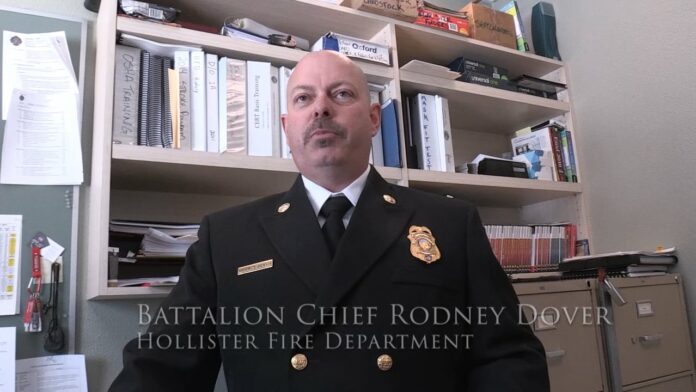Public health and emergency responders are crediting the use of an overdose reversal medication—recently put into regular use by local first responders—for potentially saving two local lives in separate, recent incidents.
San Benito County Public Health Services officials Tuesday said the Hollister Fire Department’s use of naloxone reversed the impacts of two separate and severe overdoses in Hollister that occurred in recent days.
Local agencies started using the overdose reversal drug in the spring after receiving training and doses through a grant provided by the California Department of Public Health to San Benito County Emergency Medical Services and Public Health Services. San Benito public health and emergency services agencies applied for and received doses directly from the state, said Dr. Gail Newell, public health officer for San Benito County.
“We’re very excited about this,” Newell said regarding the successful use of the medication.
San Benito County Public Health Services has been out front in the fight against opioid addiction. On a related note, the agency helped to organize local efforts in May joining other counties in suing opioid pharmaceuticals alleging a public nuisance, corruption, false advertising, negligent misrepresentation and unjust enrichment. The county filed it May 9 in the U.S. District Court Northern District of California, according to the lawsuit document.
With naloxone, local training and doses went to local entities such as the Hollister Fire Department, Hollister Police Department, San Benito County Probation, San Benito High School and the Hollister School District, said Mary White, a pharmacist and contractor with public health services.
The San Benito County Sheriff’s Office has obtained doses for the jail and juvenile hall, but has not committed to training or doses for operations deputies on the street.
A Hollister Fire Department battalion chief Tuesday said emergency responders are coming across an increasing number of overdose cases, making it useful for firefighters to now carry naloxone to reverse effects from the reactions.
Paramedics have been carrying the medication for years, but local fire and police crews more recently started using them with the help of the grant. Battalion Chief Rodney Dover said local firefighters have been carrying the overdose reversal medication since mid-April.
That’s due to the increasing commonality of drug overdose cases, particularly with opioids. Overdoses can slow a person’s heart rate and cause the heart to stop, Dover said. He has noticed a sharp increase in overdose cases in recent times, with the opioid “craze” helping to fuel the problem.
“It’s become a common problem here,” Dover said. “It’s not too uncommon to see the overdoses late in the evenings.”
He said responders have treated several overdose cases at the local Jack In the Box in recent months. He said people have overdosed in the dining room and other areas of the fast-food restaurant.
From Dover’s experience, it’s been beneficial for firefighters to carry the medication.
“It just gives us another tool in the toolbox,” he said.
Dover noted that firefighters use a nasal spray version of the medication.
Once administered, naloxone usually works to reverse the overdose within a couple of minutes and sometimes must be repeated. Its effects last anywhere from 30 to 60 minutes, hopefully enough time to get medical help for the patient, according to the local public health department.
That extra time is sometimes crucial, with first responders often on scene minutes before paramedics.
“Sometimes there’s a several-minute gap between the time they arrive and the time the first responders arrive,” Newell said, noting how it could be a couple minutes of 20 minutes. “That may be the difference between life and death for someone experiencing an opioid overdose.”
Newell even suggested that people close to those who are possibly “susceptible” to overdose or addiction should carry naloxone, which doesn’t require a prescription.
“And it’s covered by good samaritan law so there’s no liability,” she said, adding how with the nasal spray, “You really can’t do any harm.”
Local efforts to bring the overdose reversal medication to first responders tie back to the San Benito County Opioid Taskforce’s efforts and recommendations.
According to public health:
The San Benito County Opioid Taskforce was created last fall to help address issues of opioid use and overuse within our community. The taskforce is a cross-collaborative group which includes such agencies as law enforcement, Behavioral Health, Public Health, Emergency Medical Services, local government and education, health care providers, pharmacists, the local food bank and community members, among others.
The Opioid Taskforce continues to work on strategies to reduce opioid misuse and potential overdoses in our community such as: naloxone training and distribution, education and outreach, expansion of substance abuse resources, safe disposal of unused opioid prescriptions
For more information on the San Benito County Opioid Taskforce and/or naloxone, please call San Benito County Public Health Services at (831) 637-5367 or go to San Benito Public Health Services website at http://hhsa.cosb.us/ or visit www.cdph.ca.gov.




